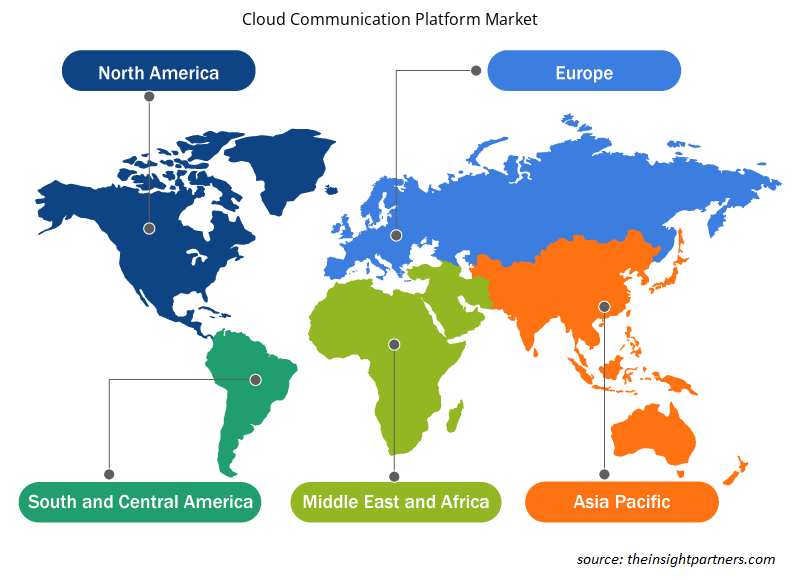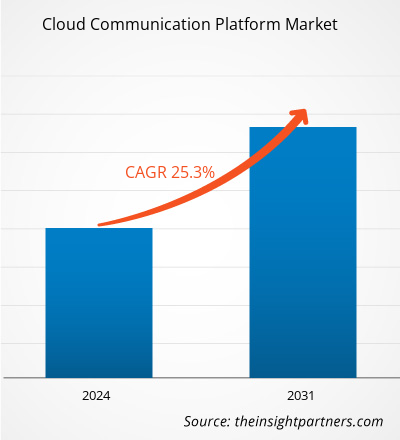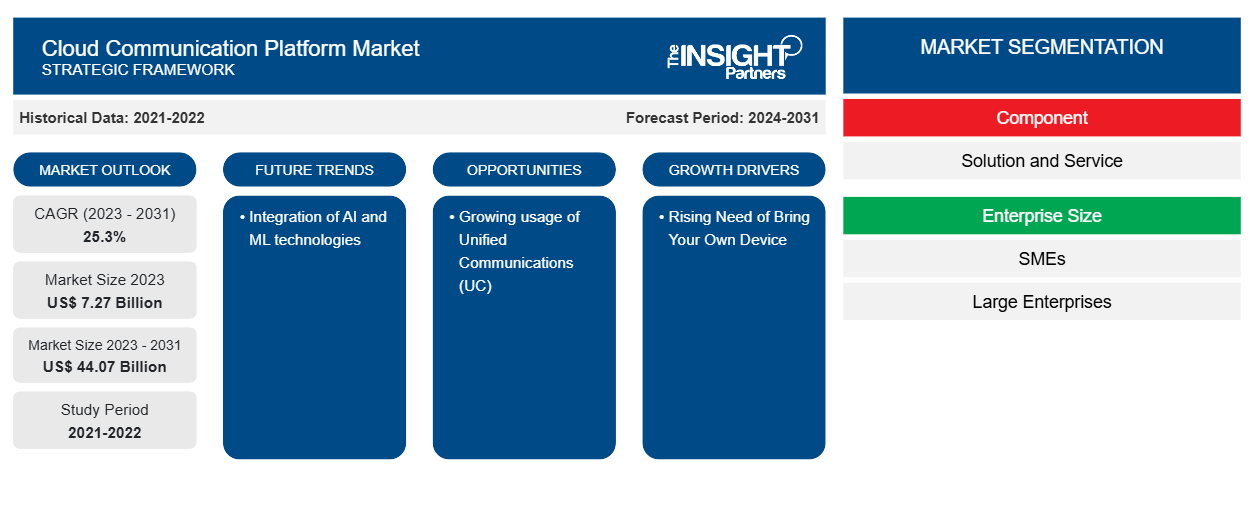Der Markt für Cloud-Kommunikationsplattformen soll von 7,27 Milliarden US-Dollar im Jahr 2023 auf 44,07 Milliarden US-Dollar im Jahr 2031 anwachsen. Der Markt wird zwischen 2023 und 2031 voraussichtlich eine durchschnittliche jährliche Wachstumsrate (CAGR) von 25,3 % verzeichnen. Die Integration von KI- und ML-Technologien dürfte ein wichtiger Trend auf dem Markt bleiben.
Marktanalyse für Cloud-Kommunikationsplattformen
Der zunehmende Trend „Bring-your-own-device“ (BYOD) mit dem Schwerpunkt auf dem Angebot flexibler Arbeitsoptionen begünstigt das Wachstum des Marktes für Cloud-Kommunikationsplattformen.
Marktübersicht für Cloud-Kommunikationsplattformen
Der Begriff „Cloud“ bezieht sich auf ein komplexes System aus miteinander verbundenen Computerplattformen, Netzwerken und Anwendungen, auf die Benutzer über das Internet zugreifen. Anstatt einen riesigen Computer (Server) am Arbeitsplatz zum Speichern und Austauschen von Dateien zu benötigen, sind alle Verarbeitungs-, Speicher-, Netzwerk- und Anwendungsressourcen über das Internet zugänglich. Wichtige Lieferanten stellen eine große Menge an Verarbeitungsleistung zur Verfügung, von der Ihr Team nur einen Prozentsatz nutzt. Dadurch kann das Team nur auf die Menge an Rechenleistung oder Speicher zugreifen, die es zu einem bestimmten Zeitpunkt benötigt, anstatt einen großen Server verwalten zu müssen. So kann sich das IT-Team auf das konzentrieren, was für das Unternehmen am wichtigsten ist, anstatt sich mit den Komplikationen herumschlagen zu müssen, die damit verbunden sind, sicherzustellen, dass die Server sicher, gekühlt und gewartet sind. Die Verwendung einer Cloud-Kommunikationsplattform senkt die Kosten erheblich und erhöht gleichzeitig die Agilität des Unternehmens.
Passen Sie diesen Bericht Ihren Anforderungen an
Sie erhalten kostenlos individuelle Anpassungen an jedem Bericht, einschließlich Teilen dieses Berichts oder einer Analyse auf Länderebene, eines Excel-Datenpakets sowie tolle Angebote und Rabatte für Start-ups und Universitäten.
-
Holen Sie sich die wichtigsten Markttrends aus diesem Bericht.Dieses KOSTENLOSE Beispiel umfasst eine Datenanalyse von Markttrends bis hin zu Schätzungen und Prognosen.
Treiber und Chancen auf dem Markt für Cloud-Kommunikationsplattformen
Steigender Bedarf an Bring-Your-Own-Device-Lösungen für den Markt
Die BYOD-Richtlinie (Bring Your Own Device) ermöglicht es Mitarbeitern, ihre privaten Geräte für geschäftliche Zwecke zu verwenden. Bei dieser Vorgehensweise werden Daten in der Cloud gespeichert. Die Daten können jederzeit und überall problemlos angezeigt werden. Der wachsende BYOD-Trend im Unternehmenssektor ist ein wichtiger Faktor für den weltweiten Markt für Cloud-Kommunikationsplattformen. Mobilität gilt als einer der drei wichtigsten Kollaborationstrends für KMU (kleine und mittlere Unternehmen). Etwa 67 % der Mitarbeiter verwenden bei der Arbeit mittlerweile ihre eigenen Geräte und fast 39 % der Unternehmen haben eine formelle BYOD-Richtlinie eingeführt. Indem KMU die Geräte ihrer Mitarbeiter mit Cloud -Diensten ausstatten, bieten sie ihren Mitarbeitern Zugriff auf alles, was sie zur Erledigung ihrer Aufgaben benötigen, sei es zu Hause oder im Büro.
Darüber hinaus steigert das BYOD-Konzept laut einem Bericht von Cisco Systems, Inc. die Produktivität der Mitarbeiter. Er zeigt auch, dass 36 % der Benutzer als hyperproduktiv eingestuft wurden. Anbieter von Cloud-Kommunikationsplattformen bauen kontinuierlich Infrastrukturen auf, um die BYOD-Implementierung im Unternehmenssektor zu unterstützen, indem sie Anwendungen wie Unternehmens-Social-Media- und Sicherheitsrichtlinienportale verbinden, von denen viele in Richtung Managed Mobility Services (MMS) führen.
Zunehmende Nutzung von Unified Communications (UC)
UC-Technologie ermöglicht die Integration von Software, die sowohl Echtzeitkommunikation (RTC), wie etwa Telefonie über IP (VoIP), als auch asynchrone Kommunikation, wie etwa persistenten Chat, unterstützt. So wird sichergestellt, dass der Endbenutzer von jedem physischen Standort oder digitalen Gerät aus einfachen und schnellen Zugriff auf alle wichtigen Tools in einer konsistenten Umgebung hat. Viele UC-Produkte enthalten – oder basieren sogar auf – Tools für die Teamzusammenarbeit mit Messaging-zentrierten Prozessen und kollaborativen Funktionen wie Echtzeit-Dateifreigabe und Kommentierung. Diese UC-Systeme der nächsten Generation werden oft als Unified Communications and Collaboration (UCC) bezeichnet.
Segmentierungsanalyse des Marktberichts zur Cloud-Kommunikationsplattform
Wichtige Segmente, die zur Ableitung der Marktanalyse für Cloud-Kommunikationsplattformen beigetragen haben, sind Komponente, Unternehmensgröße und Branche.
- Basierend auf den Komponenten ist der Markt nach Lösungen und Diensten segmentiert. Das Lösungssegment hatte im Jahr 2023 einen bedeutenden Marktanteil.
- Basierend auf der Unternehmensgröße ist der Markt in KMU und Großunternehmen segmentiert. Das Segment der Großunternehmen hatte im Jahr 2023 einen größeren Marktanteil.
- Nach Branchen ist der Markt in BFSI, IT & Telekommunikation, Gesundheitswesen, Einzelhandel, Regierung, Bildung und andere segmentiert. Das IT- und Telekommunikationssegment hielt im Jahr 2023 den größten Marktanteil.
Marktanteilsanalyse für Cloud-Kommunikationsplattformen nach geografischer Lage
Der geografische Umfang des Marktberichts zur Cloud-Kommunikationsplattform ist hauptsächlich in fünf Regionen unterteilt: Nordamerika, Asien-Pazifik, Europa, Naher Osten und Afrika sowie Süd- und Mittelamerika.
Nordamerika dominierte den Markt für Cloud-Kommunikationsplattformen im Jahr 2023. Diese Dominanz hängt mit der zunehmenden Nutzung von Cloud-basierten Diensten in der Region zusammen. Die Präsenz verschiedener Cloud-basierter Dienstanbieter trägt ebenfalls zum Wachstum des Marktes in Nordamerika bei. Darüber hinaus hat der Erfolg von Cloud-basierten Anbietern wie Google die Wirksamkeit und Kosteneffizienz von Cloud-Plattformen bewiesen. Cloud-Kommunikation bietet Sprach-, Daten- und Videodienste und bietet Verbrauchern mehr Alternativen als lokale oder regionale Anbieter. Die Attraktivität der Cloud-Kommunikation fördert das Wachstum von Cloud-Kommunikationssystemen.
Regionale Einblicke in den Markt für Cloud-Kommunikationsplattformen
Die regionalen Trends und Faktoren, die den Markt für Cloud-Kommunikationsplattformen im Prognosezeitraum beeinflussen, wurden von den Analysten von Insight Partners ausführlich erläutert. In diesem Abschnitt werden auch die Marktsegmente und die Geografie von Cloud-Kommunikationsplattformen in Nordamerika, Europa, im asiatisch-pazifischen Raum, im Nahen Osten und Afrika sowie in Süd- und Mittelamerika erörtert.

- Erhalten Sie regionale Daten zum Markt für Cloud-Kommunikationsplattformen
Umfang des Marktberichts zur Cloud-Kommunikationsplattform
| Berichtsattribut | Details |
|---|---|
| Marktgröße im Jahr 2023 | 7,27 Milliarden US-Dollar |
| Marktgröße bis 2031 | 44,07 Milliarden US-Dollar |
| Globale CAGR (2023 - 2031) | 25,3 % |
| Historische Daten | 2021-2022 |
| Prognosezeitraum | 2024–2031 |
| Abgedeckte Segmente |
Nach Komponente
|
| Abgedeckte Regionen und Länder |
Nordamerika
|
| Marktführer und wichtige Unternehmensprofile |
|
Dichte der Marktteilnehmer für Cloud-Kommunikationsplattformen: Deren Auswirkungen auf die Geschäftsdynamik verstehen
Der Markt für Cloud-Kommunikationsplattformen wächst rasant, angetrieben durch die steigende Nachfrage der Endnutzer aufgrund von Faktoren wie sich entwickelnden Verbraucherpräferenzen, technologischen Fortschritten und einem größeren Bewusstsein für die Vorteile des Produkts. Mit steigender Nachfrage erweitern Unternehmen ihr Angebot, entwickeln Innovationen, um die Bedürfnisse der Verbraucher zu erfüllen, und nutzen neue Trends, was das Marktwachstum weiter ankurbelt.
Die Marktteilnehmerdichte bezieht sich auf die Verteilung der Firmen oder Unternehmen, die in einem bestimmten Markt oder einer bestimmten Branche tätig sind. Sie gibt an, wie viele Wettbewerber (Marktteilnehmer) in einem bestimmten Marktraum im Verhältnis zu seiner Größe oder seinem gesamten Marktwert präsent sind.
Die wichtigsten auf dem Markt für Cloud-Kommunikationsplattformen tätigen Unternehmen sind:
- ?8X8, INC
- Avaya Inc.
- Anruffeuer
- Cisco Systems, Inc.
- NetFortris
- Vonage
Haftungsausschluss : Die oben aufgeführten Unternehmen sind nicht in einer bestimmten Reihenfolge aufgeführt.

- Überblick über die wichtigsten Akteure auf dem Markt für Cloud-Kommunikationsplattformen
Neuigkeiten und aktuelle Entwicklungen zum Markt für Cloud-Kommunikationsplattformen
Der Markt für Cloud-Kommunikationsplattformen wird durch die Erfassung qualitativer und quantitativer Daten nach Primär- und Sekundärforschung bewertet, die wichtige Unternehmensveröffentlichungen, Verbandsdaten und Datenbanken umfasst. Nachfolgend sind einige der Entwicklungen auf dem Markt für Cloud-Kommunikationsplattformen aufgeführt:
- Vonage, ein weltweit führender Anbieter von Cloud-Kommunikation, der Unternehmen bei der Beschleunigung ihrer digitalen Transformation unterstützt und Teil von Ericsson ist, hat seine Lösung Vonage Premier for Service Cloud Voice um die Integration mit Salesforce Einstein Conversation Insights erweitert. Diese KI-gestützten Erkenntnisse und Analysen ermöglichen es Marken, das Agenten- und Kundenerlebnis mit intelligenten, globalen Anruffunktionen zu verbessern – alles innerhalb von Salesforce Service Cloud Voice. (Quelle: Vonage, Pressemitteilung, Mai 2024)
- Cisco baut auf seiner Strategie für eine Sicherheitsplattform auf und stellt eine einheitliche Netzwerkplattform vor. (Quelle: Cisco, Pressemitteilung, Juni 2023)
Marktbericht zu Cloud-Kommunikationsplattformen – Umfang und Ergebnisse
Der Bericht „Marktgröße und Prognose für Cloud-Kommunikationsplattformen (2021–2031)“ bietet eine detaillierte Analyse des Marktes, die die folgenden Bereiche abdeckt:
- Marktgröße und Prognose für Cloud-Kommunikationsplattformen auf globaler, regionaler und Länderebene für alle wichtigen Marktsegmente, die im Rahmen des Berichts abgedeckt sind
- Markttrends für Cloud-Kommunikationsplattformen sowie Marktdynamiken wie Treiber, Einschränkungen und wichtige Chancen
- Detaillierte PEST/Porters Five Forces- und SWOT-Analyse
- Marktanalyse für Cloud-Kommunikationsplattformen mit Blick auf wichtige Markttrends, globale und regionale Rahmenbedingungen, wichtige Akteure, Vorschriften und aktuelle Marktentwicklungen
- Branchenlandschaft und Wettbewerbsanalyse, die die Marktkonzentration, Heatmap-Analyse, prominente Akteure und aktuelle Entwicklungen für den Markt für Cloud-Kommunikationsplattformen umfasst
- Detaillierte Firmenprofile
- Historische Analyse (2 Jahre), Basisjahr, Prognose (7 Jahre) mit CAGR
- PEST- und SWOT-Analyse
- Marktgröße Wert/Volumen – Global, Regional, Land
- Branchen- und Wettbewerbslandschaft
- Excel-Datensatz
Aktuelle Berichte
Erfahrungsberichte
Grund zum Kauf
- Fundierte Entscheidungsfindung
- Marktdynamik verstehen
- Wettbewerbsanalyse
- Kundeneinblicke
- Marktprognosen
- Risikominimierung
- Strategische Planung
- Investitionsbegründung
- Identifizierung neuer Märkte
- Verbesserung von Marketingstrategien
- Steigerung der Betriebseffizienz
- Anpassung an regulatorische Trends























 Kostenlose Probe anfordern für - Markt für Cloud-Kommunikationsplattformen
Kostenlose Probe anfordern für - Markt für Cloud-Kommunikationsplattformen